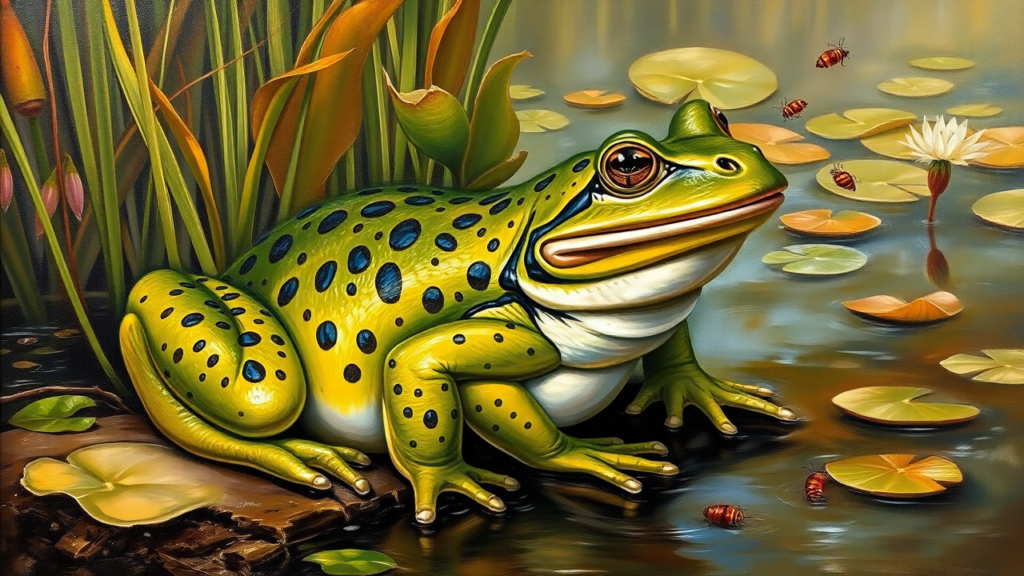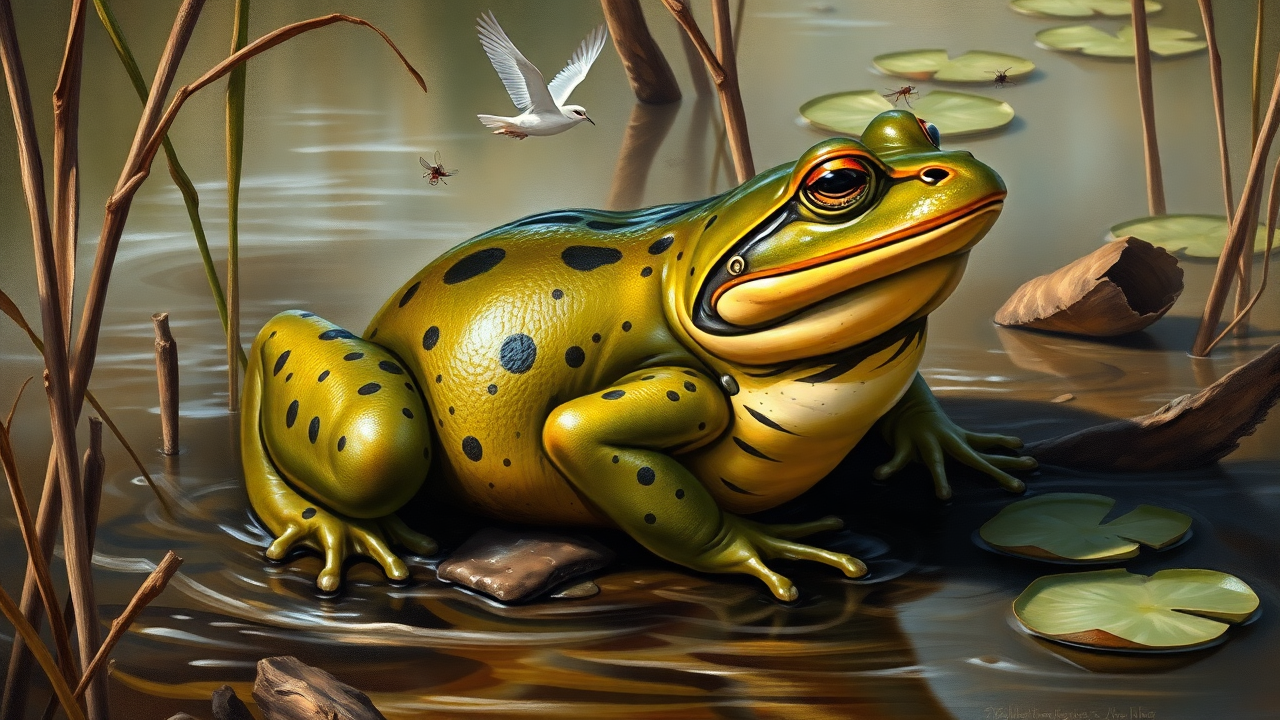The Bullfrog Barba Oliva is a unique amphibian within the bullfrog family that has yet to receive the same level of attention as its more well-known relatives. Part of the Ranidae family, it exhibits remarkable physical and behavioral characteristics that set it apart. Although the Bullfrog Barba is not as widely recognized as the American Bullfrog, its existence is an essential aspect of biodiversity, particularly in wetland ecosystems.
Characteristics of the Bullfrog Barba Oliva
Physical Description of the Bullfrog Barba
The Bullfrog Barba is typically about 5 to 7 inches long, with females being larger than males. The frog’s skin is smooth and vibrant, typically olive green with darker mottling. This coloration allows it to blend seamlessly into its environment, offering both protection from predators and a tactical advantage when hunting. One of the most notable features of the Bullfrog Barba Oliva is its large vocal sac. Males of this species use it to produce deep, resonant calls that can be heard over long distances. These calls play a critical role in attracting mates during the breeding season.
Distinctive Features
The Bullfrog Barba stands out due to its vocal capabilities. The larger vocal sac, which is unique among its relatives, allows for more powerful calls, particularly important during the mating season. Males will often compete vocally with one another, attempting to dominate the area with their calls and impress females. This feature, alongside its size and coloration, makes the Bullfrog Barba an intriguing subject for further study in the amphibian world.
Habitat and Distribution of the Bullfrog Barba
Preferred Habitat
The Bullfrog Barba prefers wetland environments, such as ponds, lakes, and marshes. These habitats provide the necessary conditions for survival, offering both shelter and abundant food sources. The frog thrives in areas where vegetation flourishes, as this provides ample hiding spots and a rich supply of prey. The Bullfrog Barba is commonly found in slow-moving water bodies, where its hunting techniques are most effective.
Geographical Range
Unlike its more widespread counterparts, the Bullfrog Barba has a relatively limited geographical range. It is found in specific regions with ideal environmental conditions. Climate plays a pivotal role in its distribution, and the frog’s presence is heavily influenced by the availability of water and the overall health of its ecosystem. These conditions are crucial for the survival of the Bullfrog Barba, as they need consistent moisture levels to thrive.
Behavior and Diet of the Bullfrog Barba
Feeding Habits of the Bullfrog Barba
The Bullfrog Barba is primarily carnivorous, with a diet that includes insects, crustaceans, and occasionally smaller amphibians or fish. This frog employs an opportunistic hunting strategy, making it highly adaptable to various prey sources. It uses its powerful legs to remain still for extended periods, waiting for prey to come within striking distance.
Hunting Techniques
The hunting style of the Bullfrog Barba Oliva is efficient and effective. This species is known for its “sit-and-wait” approach, wherein it waits patiently for prey to approach. Equipped with sharp eyesight and strong, muscular legs, the Bullfrog Barba can quickly snap up insects or other prey when the opportunity arises. This method ensures that the frog expends minimal energy while maximizing its chances of catching prey.
Reproductive Behavior
Mating Season
The mating season for the Bullfrog Barba Oli occurs during the rainy months, when conditions are most favorable for reproduction. During this period, male frogs engage in vocal competitions, using their deep croaks to assert dominance and attract females. These calls can be heard from great distances, as the vocal sacs of males are well-developed and capable of producing loud, resonant sounds.
Egg Laying and Tadpole Development
After mating, females lay their eggs in shallow water, often in areas rich with vegetation. The eggs hatch into tadpoles, which undergo a metamorphosis to become fully aquatic adults. This process can take several months, depending on water temperature and other environmental factors. Tadpoles transition from breathing through gills to using lungs, marking a significant change as they develop into adult frogs. The Bullfrog Barba reproductive cycle is heavily dependent on the health of its environment, making it vulnerable to habitat disruption.
Conservation Status of the Bullfrog Barba Oliva

Threats to the Bullfrog Barba
The Bullfrog Barba Oliva faces numerous threats that could jeopardize its existence. Habitat loss is one of the most pressing challenges, as wetlands are increasingly drained for agriculture or urban development. The frog’s reliance on moist environments makes it highly susceptible to changes in its habitat.
Habitat Loss
Urban expansion and agricultural activities contribute to the destruction of wetlands, which serve as the primary habitat for the Bullfrog Barba. Wetland drainage, for instance, significantly reduces available habitats, forcing the frog into smaller, more fragmented areas. This makes it harder for populations to survive and reproduce, ultimately threatening the species’ long-term survival.
Pollution
Pollution in aquatic environments is another major threat to the Bullfrog Barba. Chemicals from pesticides, fertilizers, and other pollutants can contaminate the water, affecting the health of the frog and its ability to reproduce. Polluted water can lead to the death of tadpoles or disrupt their development, further reducing the population of this already limited species.
Competition from Invasive Species
Invasive species pose significant competition to the Bullfrog Barba, particularly in terms of food sources and breeding sites. Non-native species, such as certain fish or predatory insects, can outcompete the frog for resources, diminishing its chances of survival. Additionally, invasive species may prey on the frog’s eggs or tadpoles, further depleting its population.
Previous Article: Simon Miller Halabalee Shirt
Conservation Efforts for the Bullfrog Barba
Despite these challenges, various conservation efforts are underway to protect the Bullfrog Barba Oliva. These initiatives focus on restoring wetland habitats, raising public awareness, and conducting research into the species’ needs.
Habitat Restoration
Efforts to restore wetland ecosystems are crucial to the survival of the Bullfrog Barba. By returning drained or damaged wetlands to their natural state, conservationists can help reestablish a stable habitat for the species. These restoration projects are essential for creating an environment where the frog can thrive, providing it with the necessary resources to survive and reproduce.
Public Awareness and Education
Public education plays a vital role in the conservation of the Bullfrog Barba. By raising awareness about the importance of preserving amphibian populations and their habitats, conservationists can garner support for protective measures. Educational programs also encourage communities to take an active role in protecting local wetlands and advocating for the species’ survival.
Research on the Bullfrog Barba
Ongoing research into the biology, behavior, and reproductive habits of the Bullfrog Barba is essential for developing more effective conservation strategies. Understanding the frog’s specific needs and how it interacts with its environment will help scientists create targeted solutions for preserving its population. Research will also shed light on the broader ecological role of the Bullfrog Barba, further underscoring the importance of its conservation.
Conclusion
The Bullfrog Barba may not be as well-known as other members of the bullfrog family, but it plays a vital role in maintaining the health of wetland ecosystems. With habitat loss, pollution, and invasive species threatening its survival, it is crucial to take action to protect this unique amphibian. By restoring wetlands, raising public awareness, and conducting ongoing research, we can ensure that the Bullfrog Barba Oliva continues to thrive for generations to come.
Understanding and protecting species like the Bullfrog Barba reminds us of the interconnectedness of life and the importance of preserving biodiversity. Every species, no matter how small or obscure, plays an essential part in the ecological balance of our planet. It is our responsibility to protect them, ensuring a healthy and sustainable environment for all living organisms.
4o mini

Leave a Reply